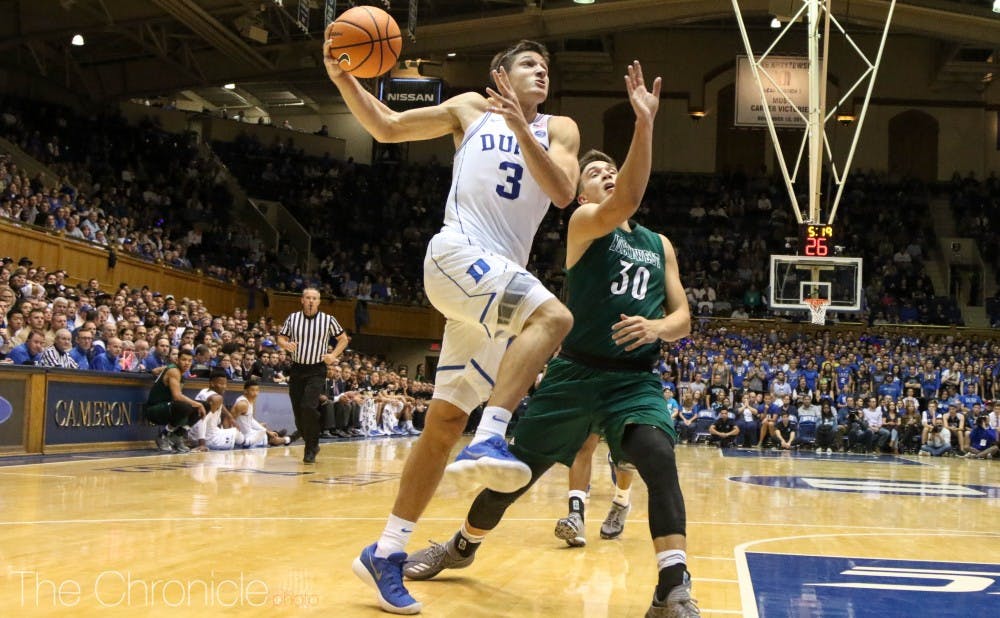While teams across the nation strive for an advantage either in size or quickness down the court, the Blue Devils enter the 2017-18 season looking to utilize a dangerous combination of height and mobility.
After relying largely on half-court offensive sets and isolation last year, Duke is ready to pick up the pace this season and increase its offensive production in transition. Although this might be surprising to hear from a team in which four of its top seven guys are at least 6-foot-9, the athleticism of this Blue Devil team certainly contributed to its preseason No. 1 ranking.
Highly-touted 6-foot-11 freshman Marvin Bagley III and 6-foot-10 classmate Wendell Carter Jr., in addition to sophomore bigs Marques Bolden and Javin DeLaurier, have shown their ability to pick up the pace and finish down at the other end of the court.
“I love how big and athletic we are,” freshman guard Trevon Duval said at the team’s media day in October. “We can get up and down the court and run and get a lot of highlight plays, but we also are big in the halfcourt set, and on defense, we’re going to cause a lot of problems for teams.”
Teams that can get out in transition are often able to have a personnel advantage offensively, leading to higher percentage shot attempts. Since most teams do not have mobile big men, Duke’s ability to get down the court faster than its opponents would give the Blue Devils an edge.
In order to make this dream a reality, they have spent their offseason focusing on conditioning and training, with the goal of becoming the most athletic team in the nation. Senior captain Grayson Allen has taken this objective to heart and has made significant strides, losing almost 20 pounds from a year ago.
“I’ve been running a lot and trying to get in really good shape,” Allen said at ACC media day. “I think I’m back down close to my freshman year weight. Stronger than I was my freshman year, but back down to that weight. It just feels better. Sophomore year, I was at 215, 220, and I was a little bit too big.”
Allen also cited the team’s recent usage of technology as an aid for improved conditioning. One product, Whoop, has been a contributor to Allen’s ability to slim down. The Whoop band mainly tracks strain in recovery and sleep, allowing players to monitor their own health while teaching them what they need to improve on for recovery.
Whoop is just one of many forms of conditioning technology used by the Blue Devils, who strive to use the most up-to-date devices in order to maintain a physical advantage over their opponents.
“We use a lot of other technology during practice,” Allen said. “A lot of stuff that tracks our motion and movement, tracks the load that’s being put on our bodies during practice, and the coaches are using it to just measure our workload, make sure we’re not doing too much, and at the same time not doing too little. It’s been a really good tool for us, especially this summer when we’re doing conditioning and not really playing any games.”
Conditioning is a key for success on the court, and arguably more important than shooting, defending or any other aspect of the game. A player’s ability to shoot does not matter if he cannot find an open shot, and a large component of a player’s defensive skillset is the ability to keep up with his man for an entire game.
Duke head coach Mike Krzyzewski feels that conditioning and off-ball skills are seldom practiced, although players are without the ball for the majority of the game.
“If you play in a 40-minute game, even if you’re the point guard, if you have the ball more than 10 minutes, most guys have it less than two minutes,” Krzyzewski said. “When you have those individual workouts, you never work on the things that you’re going to do most of the time, which is play without the ball.”
Although the Blue Devils are trying to push the tempo more this season, they have had to proceed with caution. Duke was battered by injuries last season across the board, which derailed the team’s development early on.
Jayson Tatum was able to recover from a foot injury to earn a spot on the ACC All-Freshman team, but Harry Giles and Marques Bolden’s respective knee and lower-leg injuries took them out of the equation for much of the season, as the two served merely as role players down the stretch rather than dominant post players as expected.
These injuries prompted a change in the process, as this young Blue Devil team with seven scholarship freshmen will need its share of healthy contests before finding its cohesiveness and chemistry.
“We did some things very differently than what we did the previous summer, and it’s paid dividends so far,” Duke associate head coach Jeff Capel said. “Hopefully, it continues to and we can stay away from injuries.”
Ben Leonard, Hank Tucker and Andrew Donohue contributed reporting.
Get The Chronicle straight to your inbox
Signup for our weekly newsletter. Cancel at any time.
Digital Strategy Director for Vol. 115, Michael was previously Sports Editor for Vol. 114 and Assistant Blue Zone Editor for Vol. 113. Michael is a senior majoring in Statistical Science and is interested in data analytics and using data to make insights.

